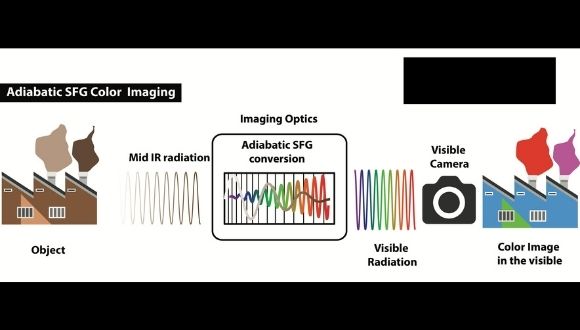
Seeing the World in New Colors
A New Technology Allows to See and Capture on Camera Colors Unseen by the Human Eye
A new development of Tel Aviv University will allow us to identify on a “standard” camera, colors that the human eye and even ordinary cameras are unable to pick up. Among other things, the new technology will make it possible to image gases such as hydrogen, carbon and sodium, each of which has a unique color in the infrared or different biological substances that are found in nature but are “invisible” in the visible. The new technology has groundbreaking applications in a variety of fields – from everyday life, gaming and photography, through security, medicine and ending with remote sensing satellites in space.
Beyond what the eye sees
The groundbreaking research was conducted by Dr. Michael Mrejen, Yoni Erlich, Dr. Assaf Levanon and Prof. Haim Suchowski from the Department of Physics of Condensed Material at Tel Aviv University. The results of the study were recently published in the peer-reviewed journal “Laser & Photonics Reviews”.
“The human eye picks up photons at wavelengths between 400 nanometers – the blue color, and 700 nanometers – the red color,” explains Dr. Mrejen. “But it is only a tiny part of the electromagnetic spectrum, which also includes radio waves, microwaves, X-rays and more. Below 400 nanometers there is ultraviolet radiation, or UV, and above 700 nanometers there is the infrared radiation, which itself is divided into near, mid and far infrared. “In each of these parts of the electromagnetic spectrum there is a great deal of information on materials encoded as “colors” that has until now been hidden from view.” The researchers explain that the color in these parts of the spectrum is of great importance, since many materials have a unique signature, expressed as color, in the mid infrared range. Thus, for example, cancer cells could be easily detected as they have a higher concentration of molecules of a certain type. Existing infrared detection technologies are expensive and mostly unable to render those “colors”. In medical imaging, experiments have been performed in which infrared images are converted into visible light to identify the cancer cells by the molecules. To date, this conversion has been done color by olor and this required very sophisticated and expensive cameras, which were not necessarily accessible in the civil sector . In the study, the researchers were able to develop cheap and efficient technology that could mount on a standard camera and in fact allows for the first time to convert the photons of light from the entire mid infrared region to the visible region, at frequencies that the human (and standard camera) can pick up.
New colors. The technology that will change the way we see the world
The fingerprint of a color
“In the mid infrared, there is a one-to-one relationship between materials and their mid-infrared “colors”, especially organic molecules,” explains Prof. Suchowski. “Meaning, different materials have a different ‘fingerprint’ color. We humans see between red and blue. If we could see in the infrared realm, we would see that elements like hydrogen, carbon and sodium have a unique color. An environmental monitoring satellite that would take a picture in this region would see a pollutant being now emitted from a plant, or a spy satellite would see where explosives or uranium are being hidden. In addition, since every object emits heat in the infrared, all this information can be seen even at night.”
After registering a patent for their invention, researchers from Tel Aviv University are currently developing the technology through a grant from the Innovation Authority’s KAMIN project, and they have already met with a number of companies – Israeli and Globao. “In the future we will be able to offer a device based on our unique crystal at a cost of a few hundred dollars, which could also be mounted on an iPhone – then everyone will be able to see at night, in colors not seen so far, providing an unimaginable wealth of information on our surroundings” concludes Prof. Suchowski.